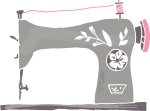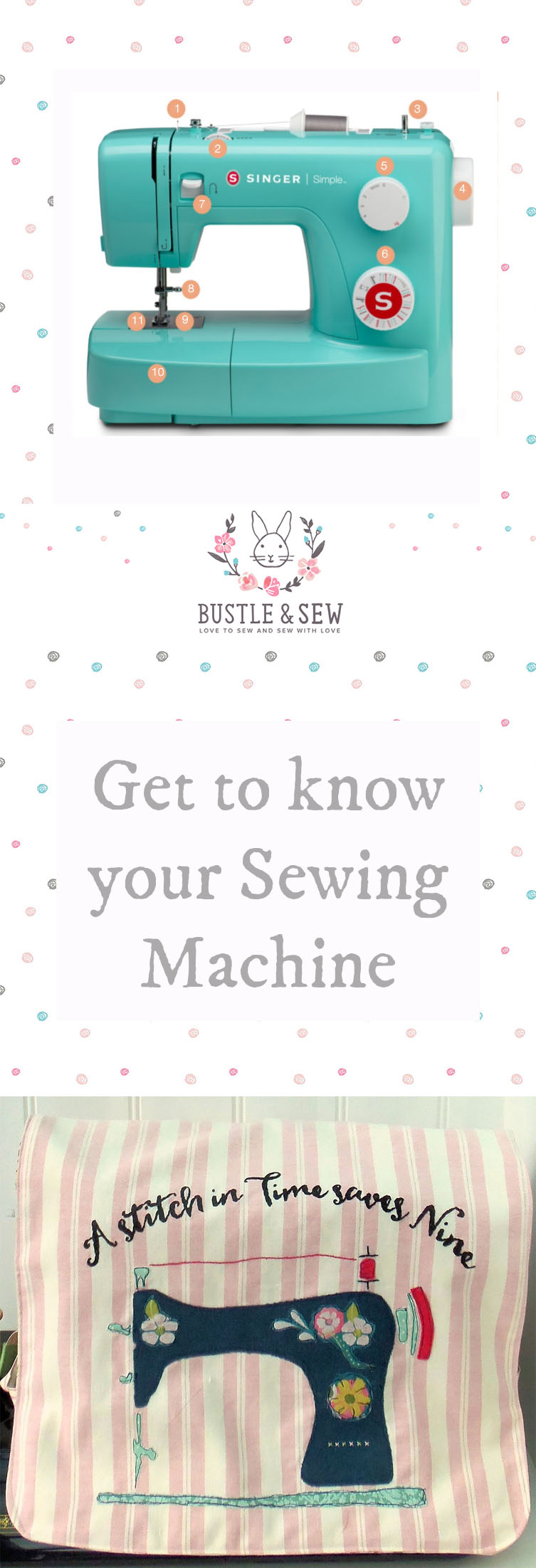
1. Thread Feed: The needle thread comes from a spool on the top of your machine and, in order to achieve the correct tension and feed, must pass through a series of channels and loops before you actually thread it through your needle (your manual will explain how this is done).
2. Needle Tension Dial: Your machine will have a numbered dial that you can use to adjust the needle thread tension when working with different fabrics. There is no equivalent for the bobbin thread. You should not normally need to adjust bobbin thread tension.
3. Bobbin Winder: The bottom, or bobbin, thread must be wound onto a bobbin before it can be used. To do this you disengage the fly wheel (normally there’s a pull out in the centre) so the machine doesn’t try to stitch while you’re winding the bobbin. Then thread the end through one of the holes in the edge of the bobbin, place it on the special winder and use the presser foot to wind the thread onto the bobbin. Go slowly at first until the thread is secure enough to let go of the loose end, and slow down towards the end too otherwise the thread may begin to wind itself around the actual winder once the bobbin is full (voice of experience!)
4. Fly or Hand Wheel: You can use this to move the needle up and down by hand. It’s great for controlling your stitching in difficult places and working corners. You should always turn the wheel towards you as otherwise the thread may become caught or tangled.
5. Stitch Length Dial: Simply turn the dial to change the stitch length, whether you’re working basic straight stitch or another pattern. A longer length is great for basting and also gathering, whilst standard sewing usually has a length of around 2 to 2.5 on your dial.
6. Stitch Selector: Most machines have at least a choice of straight and zigzag stitch and some have very many more. The chances are that you’ll probably only need to use basic straight and zigzag on a regular basis.
7. Reverse: On almost every machine there will be a button, switch or tab that enables you to sew in the reverse direction. This is the easiest technique to start and finish your sewing – just stitch forwards and backwards for a few stitches to secure the ends of your threads. Note: for an extraneat and secure finish you may wish to cut the end threads longer than usual and secure them by hand – great if you’re working with slippery or fine fabrics such as chiffon or gauze.
8. Needle: Manufacturers will recommend the type of needles to be used with their machines, and many come with a needle already in place and possibly a spare too. The needle simply slides into a socket on the end of the metal arm – you can’t get it the wrong way round as one side is flat and the other curved. You then tighten the screw to hold it in place. It’s worth checking the screw is still tight as you’re sewing vibration can cause it to work loose.
9. Feed Dogs: are pointed teeth that sit beneath the presser foot and guide the fabric through the machine. As the needle is moving the feed dogs move the fabric under the presser foot. You have to be able to drop the feed dogs – that is to lower them out of the way – to do freehand machine embroidery and your manual should tell you how to do this.
10. Free Arm: You can remove a section of your machine base to reveal a much narrower “arm” that enables you to sew narrow tubes of fabric such as sleeves, trouser legs, and bag tops without too much difficulty. This is a standard feature on every machine I have encountered.
11. Foot: This is an attachment that sits beneath your needle and holds your fabric in place against the feed dogs. Your machine will have a lever to move it up and down so you can position your fabric. It should always be down when you are sewing as otherwise your fabric won’t move through the machine and you won’t have the correct tension in your needle. Most machines come with a variety of feet – the basic presser foot is the one you’ll use most of the time.
12. Foot Pedal: (not shown in photo) This is pressure sensitive and controls the speed of your machine. You press down just a little to stitch slowly and press further to go faster.

We hope you’ve found our (very!) little guide useful – if you’d like to receive more hints & tips straight to your inbox then just click below to sign up to our free newsletter!

Leave a Reply